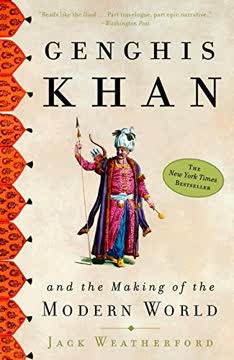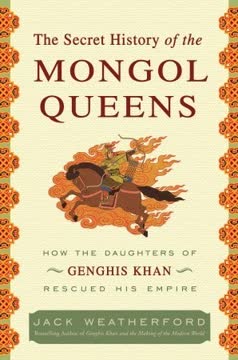Key Takeaways
1. From Outcast to Conqueror: Genghis Khan's Brutal Origins
You came from my hot womb clutching a clot of blood in your hand.
Born into hardship. Temujin, the future Genghis Khan, was born into a world of extreme tribal violence on the remote Mongolian steppe. His early life was marked by tragedy and betrayal:
- Kidnapping of his mother, Hoelun, from her first husband.
- Abandonment by his father's clan after his father was poisoned.
- Living as an outcast, scavenging for survival with his widowed mother and siblings.
- Killing his older half-brother, Begter, in a dispute over food.
- Capture and enslavement by a rival clan, the Tayichiud.
Shaped by trauma. These early experiences instilled in him a deep understanding of human cruelty, a fierce instinct for survival, and a profound distrust of traditional tribal structures based solely on kinship. His mother's harsh words upon discovering he had killed Begter foreshadowed the bloody path he would forge.
Defying destiny. Despite these degraded circumstances, Temujin showed remarkable resilience and determination. His ability to escape enslavement and inspire loyalty in others, even those outside his clan, set him on a path to defy the low station into which he was born and begin his long climb to power.
2. Unifying the Steppe: Loyalty Over Kinship
We ate the food that is not to be digested, and we spoke to each other the words that are not to be forgotten.
Breaking tradition. Temujin's rise was built on forging alliances based on personal loyalty and merit, rather than relying on the unreliable bonds of kinship that had failed him in youth. His most significant early relationship was with Jamuka, his sworn blood brother (anda).
Anda vs. Kin. The oath of anda was considered stronger than biological brotherhood, a bond freely chosen. Temujin and Jamuka swore this oath twice in childhood and once as young men, sharing intimate moments and exchanging symbolic gifts. However, their differing views on leadership and the traditional aristocratic hierarchy eventually led to a bitter rivalry.
Meritocracy emerges. Temujin's experiences taught him that loyalty from those outside his clan could be more reliable than ties within it. This led him to promote individuals based on their abilities and devotion to him, a radical departure from the steppe's rigid aristocratic system. This principle became a cornerstone of his unified Mongol nation.
3. The Mongol War Machine: Speed, Discipline, and Terror
Victory did not come to the one who played by the rules; it came to the one who made the rules and imposed them on his enemy.
Pragmatic warfare. Genghis Khan transformed warfare from episodic raids into a total commitment. His military genius lay in adapting nomadic hunting strategies and incorporating foreign technology, not adhering to chivalrous codes.
- Hunting tactics: Used formations like the 'Moving Bush' and 'Crow Swarm' to disorient and surround enemies, similar to hunting prey.
- Speed and mobility: Relied entirely on cavalry, traveling light without supply trains, using relay horses for rapid movement ('Lightning Advance').
- Discipline: Enforced strict obedience; units of ten fought as brothers, forbidden to leave anyone behind.
Psychological warfare. Terror was a calculated weapon. By destroying cities utterly and spreading exaggerated tales of brutality, the Mongols aimed to induce surrender before battle.
- Refugee waves: Attacked villages to send terrified peasants fleeing into cities, straining resources and morale.
- Human shields: Forced captives to march ahead of the army during sieges.
- Propaganda: Used scribes and envoys to spread terrifying stories, often inflating casualty numbers.
Technological adaptation. Mongols were quick learners, incorporating siege engines, gunpowder weapons (firelances, proto-grenades), and engineering skills (undermining walls, diverting rivers) from conquered civilizations, particularly Chinese and Muslim engineers.
4. Global Conquest: Shattering Old World Orders
In twenty-five years, the Mongol army subjugated more lands and people than the Romans had conquered in four hundred years.
Unprecedented scale. Starting with the Jurched in 1211, Genghis Khan launched a series of campaigns that rapidly expanded the Mongol Empire across Asia.
- Jurched (North China): Conquered through a mix of military pressure, exploiting ethnic divisions (Khitan), and siege warfare innovations.
- Khwarizm (Central Asia/Persia): Attacked in response to trade caravan looting and envoy mutilation, destroying a vast, sophisticated Muslim empire in just a few years.
- Tangut (Western China): Subdued after initial resistance, serving as a testing ground for siege tactics.
Redrawing the map. The conquests consolidated smaller kingdoms into larger entities, laying the groundwork for modern nations like Russia, China, and Korea.
- Russia: United disparate Slavic principalities under Mongol rule (Golden Horde).
- China: Combined various dynasties and kingdoms (Jurched, Tangut, eventually Sung) into a unified state under the Yuan dynasty.
Total victory. Unlike previous conquerors who might accept tribute or partial submission, Genghis Khan sought complete, undeniable triumph. Resistance was met with annihilation, loyalty with protection and inclusion.
5. The Pax Mongolica: Connecting East and West
By the time of his death in 1227, he had connected them with diplomatic and commercial contacts that still remain unbroken.
A unified world. The Mongol Empire, at its height, spanned from the Pacific to the Mediterranean, creating the largest contiguous land empire in history. This vast territory, though forged in conquest, ushered in an era of unprecedented peace and connectivity.
Facilitating exchange. The Mongols actively promoted trade and communication across their domains.
- Secure trade routes: Established and protected routes (later known as the Silk Road), making travel safer than ever before.
- Postal system: Created a vast network of relay stations (yam/ortoo) for rapid communication and transport of people and goods.
- Standardization: Introduced standardized weights, measures, and paper currency to ease commerce.
Cultural diffusion. The empire became a conduit for the transfer of ideas, technologies, and cultures between East and West.
- Technology: Spread Chinese inventions like printing, gunpowder, and the compass westward.
- Knowledge: Facilitated the exchange of medical, astronomical, and mathematical knowledge between Muslim, Chinese, and European scholars.
- Crops and goods: Introduced new crops (carrots, lemons) and commodities (carpets, tea, playing cards) across continents.
Global interaction. For the first time, Europeans, Muslims, Chinese, and Indians were brought into direct and sustained contact, leading to a "Global Awakening" that reshaped all participating civilizations.
6. A New Kind of Empire: Meritocracy, Law, and Tolerance
As he smashed the feudal system of aristocratic privilege and birth, he built a new and unique system based on individual merit, loyalty, and achievement.
Radical social reform. Genghis Khan dismantled traditional hierarchies based on kinship and aristocracy, replacing them with a system based on personal loyalty and demonstrated ability.
- Merit-based promotion: Elevated individuals from low-status backgrounds to high military and administrative positions.
- Inclusion: Incorporated conquered peoples into the Mongol army and society, often as full members rather than slaves.
Rule of Law. He established a universal legal code, the Great Law (Yassa), based on steppe traditions but adapted for a multi-ethnic empire.
- Equality under law: Insisted that rulers were as accountable as commoners.
- Key prohibitions: Forbade kidnapping of women, theft of animals, and inter-tribal feuding.
- Humanitarian aspects: Abolished torture and granted amnesty to repentant criminals (later refined by Khubilai).
Religious freedom. In a world often defined by religious conflict, the Mongols decreed complete religious tolerance, exempting clergy from taxes and public service. This fostered coexistence and attracted diverse talent to the Mongol court.
7. Khubilai Khan: Adapting Mongol Rule for a Sedentary World
He won control of China by appearing to be more Chinese than the Chinese, or at least more Chinese than the Sung.
Shifting focus. Genghis Khan's grandson, Khubilai Khan, faced the challenge of ruling a vast, sedentary civilization (China) rather than a nomadic empire. He adapted Mongol principles to win the allegiance of the Chinese population.
Sinicization strategy. Khubilai adopted Chinese customs, built a Chinese-style capital (Dadu/Beijing), and founded a Chinese dynasty (Yuan) to legitimize his rule in the eyes of his subjects.
- Cultural adoption: Commissioned Chinese-style portraits of ancestors, built ancestral temples, and adopted Chinese reign names.
- Urban development: Built a grand capital with broad streets, incorporating elements of both Mongol and Chinese design.
Administrative innovation. He reformed Chinese administration, often favoring foreigners (Muslims, Europeans) over traditional Chinese mandarins to ensure loyalty and introduce new ideas.
- Legal reforms: Modified Chinese law to align with Mongol principles, reducing capital offenses and limiting torture.
- Economic policies: Standardized currency, promoted paper money, and supported trade and manufacturing.
Patron of culture. Khubilai fostered cultural development, supporting drama, printing, and scholarship, often in the vernacular language, appealing to the masses rather than just the elite.
8. The Global Awakening: Unprecedented Exchange of Knowledge and Technology
The Mongols swept across the globe as conquerors, but also as civilization’s unrivaled cultural carriers.
Bridging continents. The Mongol Empire facilitated a massive transfer of knowledge and technology across Eurasia, connecting previously isolated civilizations.
- Technology transfer: Spread Chinese inventions like printing, gunpowder, and the compass to the Middle East and Europe.
- Scientific exchange: Brought together astronomers, mathematicians, and doctors from China, Persia, and Europe, leading to advancements in cartography, medicine, and mathematics (e.g., abacus, Arabic numerals, algebra).
Agricultural diffusion. Mongols actively promoted the exchange of crops and agricultural techniques across their empire, improving productivity and dietary variety.
- Crop exchange: Transplanted crops like rice, millet, citrus fruits, and cotton between Asia and the Middle East.
- Technique sharing: Spread knowledge of irrigation, plowing techniques, and crop rotation.
Cultural blending. The interaction fostered new hybrid cultural forms, visible in art, music, and even cuisine, as different traditions mixed within the Mongol melting pot.
9. The Black Death: Unraveling the Mongol World System
The same Mongol roads and caravans that knitted together the Eurasian world of the thirteenth and fourteenth centuries moved more than mere silk and spices.
Unintended consequence. The vast, interconnected trade network established by the Mongols, while facilitating commerce and cultural exchange, also inadvertently created the perfect pathway for the rapid spread of the bubonic plague.
Epidemic of commerce. Originating in Asia, the plague traveled along Mongol trade routes, devastating populations across the empire and beyond.
- Rapid spread: Moved quickly via caravans and ships, reaching Europe by the mid-14th century.
- High mortality: Caused massive population decline, particularly in dense urban areas and isolated communities.
Collapse of connectivity. The plague disrupted trade, communication, and transportation networks, isolating regions and undermining the economic foundation of the Mongol Empire.
Political fragmentation. Deprived of trade revenue and facing demographic collapse, the different branches of the Golden Family lost their ability to maintain centralized control or support each other, leading to the empire's fragmentation.
10. The Enduring Legacy: Illusion, Inspiration, and Distortion
Genghis Khan has long passed from the scene, but his influence continues to reverberate through our time.
Lasting impact. Despite the empire's political fragmentation, its institutions and influence persisted, shaping the course of history in the regions it once controlled.
- Nation-building: Laid the foundation for modern nations like China, Russia, and Korea.
- Military innovation: Spread gunpowder technology and military organization that influenced later empires (Ottomans, Moghuls).
- Global trade: Established trade routes and commercial practices that continued to facilitate East-West exchange.
Distorted image. Genghis Khan's legacy was later manipulated and distorted by various powers for their own agendas.
- European Enlightenment: Portrayed as a symbol of Asian barbarism to justify European superiority and colonialism.
- Asian Nationalism: Reclaimed as a hero and symbol of Asian strength against Western domination.
An empire of ideas. More than a military or political entity, the Mongol Empire fostered a universalist vision of a connected world based on trade, communication, and shared knowledge, principles that became foundational to the modern era.
Last updated:
FAQ
1. What is Genghis Khan and the Making of the Modern World by Jack Weatherford about?
- Comprehensive historical narrative: The book traces Genghis Khan’s life from his birth in 1162, through his rise to power, the unification of the Mongol tribes, and the creation of the largest contiguous empire in history.
- Focus on transformation: Weatherford explores how Genghis Khan’s conquests revolutionized warfare, politics, commerce, and cultural exchange, laying the groundwork for the modern world.
- Research approach: The author combines archaeological evidence, the Secret History of the Mongols, and extensive travel to reconstruct Genghis Khan’s life and legacy, challenging the stereotype of the Mongols as mere barbarians.
2. Why should I read Genghis Khan and the Making of the Modern World by Jack Weatherford?
- Fresh perspective on Mongols: The book offers a nuanced view, portraying Genghis Khan as a visionary leader who established laws, promoted meritocracy, and fostered religious freedom.
- Insight into global impact: Readers gain an understanding of how Mongol innovations in military tactics, administration, and trade shaped Eurasian history and the roots of globalization.
- Rich historical context: Weatherford provides detailed accounts of Mongol society, spirituality, and the geopolitical landscape of the 12th and 13th centuries, enriching the reader’s grasp of world history.
3. What are the key takeaways from Genghis Khan and the Making of the Modern World by Jack Weatherford?
- Reevaluation of legacy: Genghis Khan is presented as a sophisticated ruler whose policies influenced law, governance, and cultural integration across continents.
- Mongol innovations: The book highlights the Mongols’ revolutionary military strategies, legal reforms, and the creation of a vast free-trade zone.
- Enduring influence: Weatherford connects the Mongol Empire’s legacy to the development of modern commerce, technology, and governance, showing its relevance to today’s globalized world.
4. What were the early life challenges of Genghis Khan according to Jack Weatherford?
- Harsh childhood: Born Temujin, he faced tribal violence, kidnapping, and slavery, and his family was abandoned after his father’s death, forcing them into poverty.
- Family conflict: Temujin killed his older half-brother to assert leadership, an act that shaped his ruthless determination and tactical mind.
- Formative relationships: His bond and rivalry with Jamuka, and his marriage to Borte—whose kidnapping and rescue were pivotal—deeply influenced his rise and strategies.
5. How did Genghis Khan unify the Mongol tribes as described in Genghis Khan and the Making of the Modern World?
- Military reorganization: He introduced a decimal system in the army, mixing clans to break traditional loyalties and foster merit-based allegiance.
- Legal reforms: Genghis Khan codified the Great Law, abolishing practices like kidnapping and slavery, and established religious freedom and rule of law.
- Political strategy: He eliminated rival clans, adopted conquered peoples, and used symbolic acts like the Spirit Banner to unify diverse groups.
6. What were the key military strategies and innovations of the Mongols in Jack Weatherford’s book?
- Cavalry-based mobility: The Mongol army was entirely cavalry, enabling rapid movement and surprise attacks over vast distances.
- Tactical formations and psychological warfare: They used coordinated formations, multi-front invasions, and psychological tactics like terror and siege innovations to break enemy resistance.
- Adoption of technology: The Mongols incorporated Chinese siege engineers and weapons, mastering the art of besieging walled cities and ending the era of fortifications.
7. How did the Mongol Empire govern its vast territories according to Jack Weatherford?
- Decentralized administration: The empire was divided among Genghis Khan’s descendants, each ruling different regions but maintaining allegiance to the Great Khan.
- Role of women: Women, especially widows of khans, often managed administration during regencies, playing a significant role in governance.
- Legal and economic systems: The Mongols established a universal legal code, promoted trade with a postal relay system, and standardized currency to facilitate commerce.
8. What role did women play in the Mongol Empire as detailed in Genghis Khan and the Making of the Modern World?
- Political power: Women managed affairs at home and in conquered territories, with some serving as regents and wielding significant influence.
- Succession struggles: Royal women were deeply involved in political intrigue and succession, sometimes engaging in purges and rivalries to secure power for their sons.
- Cultural patronage: Women supported religious institutions, education, and printing, contributing to the empire’s cultural and religious diversity.
9. How did Genghis Khan and the Mongol Empire influence global trade and cultural exchange?
- Pax Mongolica: The Mongols established a period of peace and stability, securing and expanding the Silk Route and enabling safe trade across Eurasia.
- Standardization and innovation: They standardized weights, measures, and currency, and issued passports to protect merchants, boosting economic integration.
- Cultural diffusion: The empire facilitated the exchange of technologies, ideas, and artistic styles, laying the foundations for the Renaissance and modern globalization.
10. What was the significance of the Spirit Banner (sulde) in Mongol culture and Genghis Khan’s life?
- Symbol of power: The Spirit Banner, made from horsehair, represented the warrior’s soul and destiny, and was central to Mongol identity.
- Spiritual guidance: It was believed to channel the power of nature and served as a guardian and inspiration for warriors.
- Legacy and mystery: The black banner, associated with Genghis Khan’s soul, was guarded for centuries and its disappearance reflects the enduring reverence and mystery of his legacy.
11. What led to the decline and fall of the Mongol Empire as explained by Jack Weatherford?
- Internal political struggles: Rivalries among Genghis Khan’s descendants weakened central authority, leading to fragmentation into independent khanates.
- Plague and economic collapse: The Black Death devastated populations and trade, undermining the empire’s stability and resources.
- Cultural assimilation: Mongol rulers adopted local customs and religions, diluting their unity and eventually losing popular support, especially in China.
12. What is the legacy of Genghis Khan and the Mongol Empire in the modern world according to Jack Weatherford?
- Foundation of global interconnectedness: The Mongol Empire created the first large-scale system linking East and West through trade, communication, and cultural exchange.
- Influence on law and tolerance: Genghis Khan’s legal code and policies of religious tolerance inspired later political systems and secular governance.
- Enduring historical impact: Despite periods of vilification, Genghis Khan is increasingly recognized as a visionary leader whose influence continues to shape Eurasian history and beyond.
Review Summary
Genghis Khan and the Making of the Modern World receives mixed reviews. Many praise its engaging narrative and fresh perspective on Genghis Khan's impact, highlighting his role in globalization and progressive policies. Critics argue it downplays Mongol atrocities and over-emphasizes their positive contributions. Readers appreciate learning about Mongol military tactics, governance, and cultural exchanges. Some question the book's historical accuracy and bias. Overall, it's considered an accessible introduction to Mongol history that challenges traditional Western views, though its revisionist approach is controversial.
Similar Books
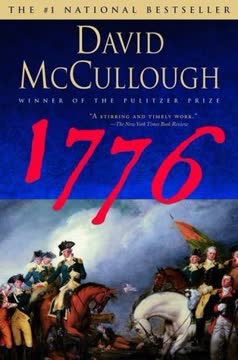
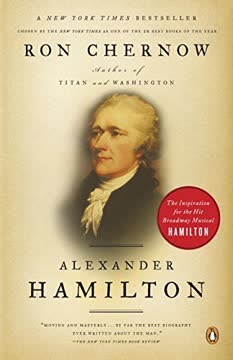
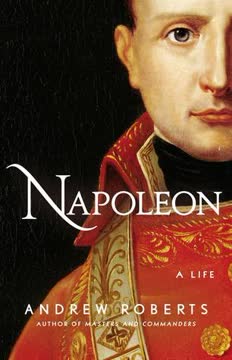
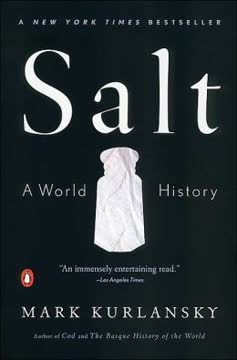
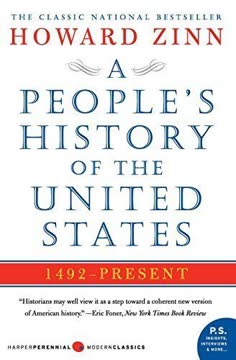
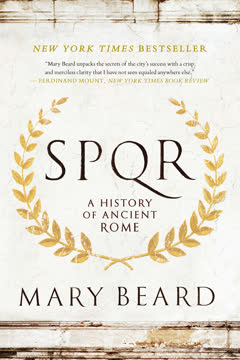
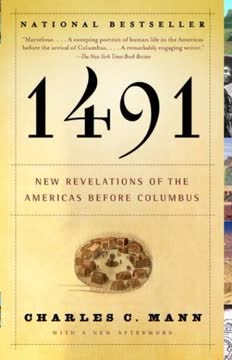
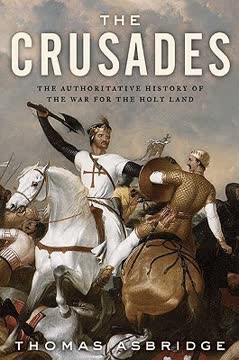
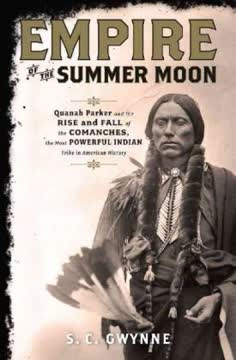
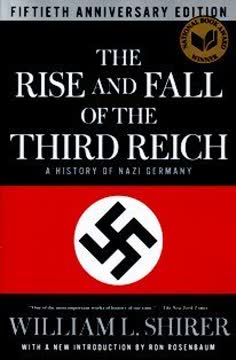
Download PDF
Download EPUB
.epub digital book format is ideal for reading ebooks on phones, tablets, and e-readers.
